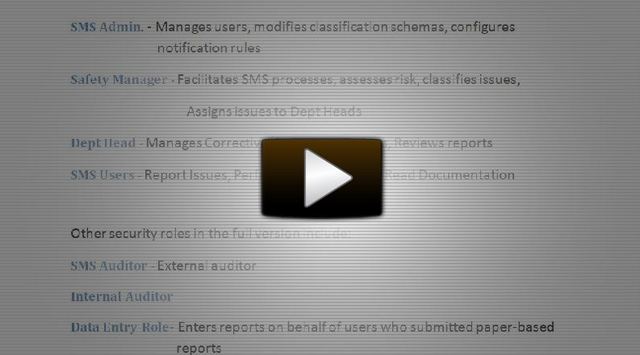Understanding SMS Pro™ security roles for non-IT users is of utmost importance if you value your risk management software application security. General aviation SMS users don't need to be seeing sensitive safety data, such as reports that may be embarrassing if they were on the front of the daily newspaper.
SMS Pro™ security is easy to implement if you understand these standard Web-based software security concepts.

Understanding Security Roles Video
SMS Pro™ security and functionality is based on security roles. Major security roles in SMS Pro™ include:
- SMS Admin: - Manages users, modifies classification schemes, configures hazard reporting email notification rules
- Safety Manager: - Facilitates SMS processes, Assesses risk, Classifies issues, Assigns issues to Dept Heads
- Dept Head: - Manages Corrective/Preventive Actions, Reviews Safety reports
- SMS Users: - Report Issues, Hazards, Quality Concerns, Perform Assigned Tasks, Reads Documentation
Other security roles in the full version include:
- SMS Auditor - Exernal auditor
- Internal Auditor
- Data Entry Role- Enters reports on behalf of users who submitted paper-based reports
- SMS Executive - Notified when high-risk events are reported or closed, Reviews performance monitoring reports
- Not Inducted - For users not inducted into the SMS program
SMS Pro™ is a very customizable, Web-based aviation SMS software program. Customized roles can be added, such as pilots or medics. Customized in your aviation SMS database software roles allow you to send newsletters or meeting invitations to select groups of users.
It is very important that you understand that program functionality and menus are dependent upon what roles a user is given. You can give a user multiple roles. For example, a Safety Manager should also be given the SMS User role so he can access basic functionality that all users can see.
As another example, let us consider auditors. SMS Auditors can view items in the Issue Manager, but they are not able to make changes. Therefore, do not give your Safety Manager the auditor role, otherwise safety managers cannot do their jobs. In short, you give auditors the Safety Manager role so they can see what Safety Managers can see; however, don't give Safety Managers the auditors' role.